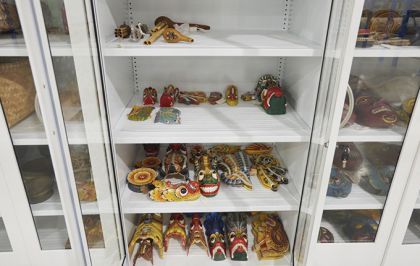Appropriate Storage for Museums - Part 1
17 October 2018
The aim for museums, when it comes to storage, is to collect and preserve items of historical significance for generations to come - whether they're on display or in boxes in a store room.

APC are experts in the design and manufacturing of customised furniture and storage solutions and as a result, have been commissioned to provide storage fit-outs for a number of museums over the years.
Many factors contribute to the long-term preservation of artefacts entrusted to the care of museums: environmental control, appropriate storage and correct handling and display. We will explore these over a series of articles, beginning with the type of storage.
Factors to consider
Determining the right storage solution will depend on:
- Facility constraints
- What is being stored
- Anticipating what storage may be required in the future
It is important to plan carefully so space is utilised without overcrowding items that may lead to damage. Shelving should be adjustable to accommodate items of varying sizes.
To determine the amount of storage required you will need to assess the extent of the existing collection and establish the rate of collection growth. Accessibility to the collection will also help determine what kind of storage system is appropriate. For example, if only staff are permitted access then simple storage systems may be appropriate, however, if the general public is allowed, the collections will need to be stored in more secure systems. Items stored by museums are valuable and rare and for this reason, security is an important consideration. Many of our products, such as our TouchDrive Aislesaver can be fitted with locking mechanisms for added security.
Material
The selection of storage furniture for archival materials requires careful consideration. Many available furniture choices contain materials that contribute to the deterioration and discolouration of objects. Powder coated metal storage furniture is preferable to wood because it is inert (chemically inactive). Wood, wood composites and some sealants emit harmful acids and substances.
Storage furniture should have a smooth, nonabrasive finish. If steel is painted or coated, the finish should be resistant to chipping, for chips will leave steel exposed and susceptible to rust. Furniture should also be free of sharp edges and protrusions; exposed nuts and bolts are particularly hazardous.
Type of storage
Your storage system will depend on the size of the objects you're storing but may comprise of:
- Plan cabinets or pull our drawers for flat and small items.
- Fixed or adjustable steel shelving for the display or storage of items.
- Display shelving with glass doors for exhibiting items.
- Mobile shelving systems for storing or displaying items of varying sizes and for archive box storage.
- Long span shelving for medium to large objects and archive box storage.
- Art Racking, using vertical storage for large framed artwork in a confined space.
Mobile shelving systems (Aislesavers) are commonly used in museums because they are high-density and completely customisable, allowing for a large range of product types to fit into this system flawlessly. These systems also minimise the amount of space needed by compacting the bays of shelves or cabinets of drawers tightly together. The bays slide along the tracks so they can be moved apart for the retrieval of items and then pushed back together. APC's range of mobile shelving systems includes manual/push-pull (Ezi-Slide Aislesaver), mechanically assisted (Ezi-Drive Aislesaver) and motorised mobile (TouchDrive Aislesaver). There are a number of factors to consider when installing a mobile shelving system:
- Ensure items do not extend beyond the edge of the shelves, to avoid having items on the opposite shelves collide with them when the bays are closed.
- Make sure there is enough space so wide aisles can be opened between the bays for safe removal of items from shelves and drawers.
Regardless of the size or complexity of your storage requirements, APC is able to deliver a customised solution tailored to meet the individual requirements of your museum.